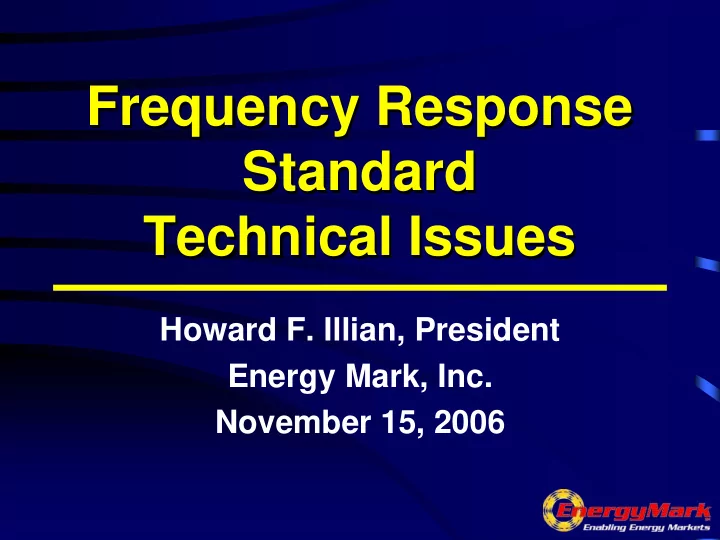

Frequency Response Frequency Response Standard Standard Technical Issues Technical Issues Howard F. Illian, President Energy Mark, Inc. November 15, 2006
Overview Overview � Frequency Response Measurement � Central vs. Local Measurement � Sampling Procedures & Bias � Local Measurement Limitation � PGFR Measurement Change � From Tie Line Error and Frequency � To ACE, Bias and Frequency � Significance of Measured PGFR
Frequency Response Plot Frequency Response Plot
Frequency Response Frequency Response � Initial Frequency – Point A � Settling Frequency – Point B � Minimum Frequency – Point C � Oscillations – from C to B
Measurement of PGFR Measurement of PGFR � Values of Interest � Minimum Frequency � Settling Frequency � Minimum - High Resolution Data � Settling Frequency – Step Function � Use Two Step Measurement ? � High Resolution Minimum Frequency � Step Function Settling Frequency � Consistent Minimum to Settling Ratio ?
Central vs. Local Measure Central vs. Local Measure � Central measurement can provide answers to reliability requirements. � If reliability is affected significantly, then local measurement is required to assign responsibility for meeting minimum reliability needs.
Sampling Procedures Sampling Procedures � Frequency Threshold � May tend to select lower response events � Minute to Minute Unit Step Function � Inconsistent selection method � 3-Minute Unit Step Function � Provides more consistent selection � Provides multiple data values � Enables internal consistency checking
Frequency Threshold Frequency Threshold � Assume 1,000 Mw Event: PGFR / 0.1 HZ Frequency Change A 1,000 MW 100 mHz B 2,000 MW 50 mHz C 3,000 MW 33 mHz � 40 mHz Sampling Limit will select A and B from above but exclude C.
Minute to Minute Minute to Minute � Assume 1,000 MW Event with a 2,000 MW / 0.1 Hz Response: Min Event at Avg 0 Sec 15 Sec 30 Sec 45 Sec 1 60.000 60.000 60.000 60.000 2 59.950 59.963 59.975 59.988 3 59.950 59.950 59.950 59.950 � Use Minute 1 to Minute 3 average.
Minute 1 - - Minute 3 Sample Minute 3 Sample Minute 1 � Minute 1 to Minute 3 sampling provides 1 or 2 samples per event. � Each event weighted equally. � Multiple sample events enable the investigation of other data inconsistencies. � This is still Frequency Threshold Sampling. Can we overcome the sampling bias in other ways?
Measurement Limitation Measurement Limitation � Balancing Authority Metering ∑ E T = 0 � Therefore: ∑ ∑ = ⋅ ⋅ = E 0 & E 0 T , 1 T , 2 � And: Δ ⎛ ⎞ ∑ ∑ E T = ⋅ ⋅ = ⎜ ⎟ 0 & FR 0 Δ ⎝ ⎠ F
Local Measure Required Local Measure Required � These equations indicate that the information required determine the contribution to unreliability is contained in the local measurements. � Therefore, local measurement is required to assign responsibility for provision of Frequency Response. � The information is contained in combined Disturbance Imbalance Errors and the resulting Frequency Response to them.
PGFR Measurement Change PGFR Measurement Change � Change PGFR Measurement � From Tie Line and Frequency � To ACE, Bias and Frequency � This change is dependent on the consistency of Variable Frequency Bias use.
Significance of PGFR Significance of PGFR � Frequency Error Drivers � Normal Control Errors � Disturbance Errors � Disturbance Recovery Errors � Scheduled Time Error Corrections � Sensitivity Variables � Epsilon 1 � Generation and Transmission Inventory � DCS Limits: Size and Recovery Limits � Time Error Correction Procedures
Questions Questions
Recommend
More recommend